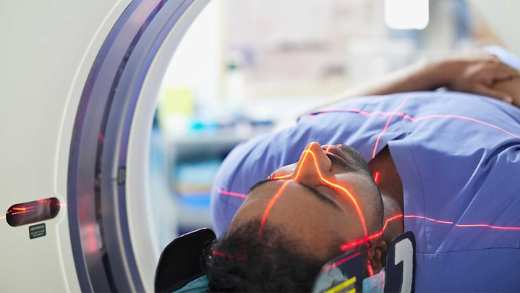MRI scan and health insurance
Magnetic resonance imaging, known as an MRI scan, is a non-invasive test that uses strong magnetic fields and radio waves to create detailed images of the inside of your body.

What is an MRI scan used for?
The scan is used to detect problems inside your body Footnote [1] or to monitor an existing condition. It can look at nearly every part of your body including:
- Heart
- Brain
- Muscles
- Nervous system
The images from the MRI scan are closely examined by the radiology team and will help them see things like unhealthy tissue, muscle and ligament tears, inflammation and tumours.
Can anyone get an MRI scan?
For the majority of people, having an MRI scan is straighforward, however if you have metallic implants or fragments in your body Footnote [2] such as a pacemaker, metal plates, wires or screws you should tell the radiographer. It doesn’t necessarily mean you won’t be able to have the scan, they’ll make a decision based on your own individual circumstances.
If you’re pregnant, suspect you may be pregnant, or breastfeeding, you should tell medical staff and a doctor will discuss any risks with you.
Small children and babies can get an MRI scan but sometimes have to have a general aesthetic or sedative to help them lie still.
MRI scans with a dye
Some conditions require an injection of Footnote [3] contrast agent to be administered before the scan to make tissue and blood vessels show up more clearly. This will depend on the area being scanned.
There can be mild side effects such as nausea, a rash, dizziness or a headache, but these don’t last very long. If you have any allergies or blood clotting problems let the radiographer know before the procedure.
If you have severe kidney disease the contrast agent can cause organ or tissue damage so you may be given a blood test to check your kidney function beforehand.
Preparing for an MRI scan
You can usually eat, drink and take medications as normal before the scan.
If you’re claustrophobic you may be feeling a rollercoaster of emotions and worried about entering the MRI scanner. When your appointment comes through it’s advisable to contact the radiography department or your consultant and discuss your options. They may advise you to take a sedative before you have your scan.
If you do have a sedative you may need to arrange for someone to drive you home afterwards in case you feel drowsy.
What happens during an MRI scan
When you arrive at your appointment you may be asked to change into a hospital gown. For a short procedure you may not need to wear one but will be asked to remove anything metallic such as belts, buckles or clothes with a metal zip.
Children can usually have an adult with them and you may be allowed a family member or friend with you, but they’ll have to follow guidelines and remove anything metal from their clothing or body.
You’ll be told how long your scanning process will take and the intervals. The radiographer may talk to you during the procedure to tell you you’re halfway through, or that this is the last scan. The whole procedure can take from up to 90 minutes depending on what part of your body is being scanned.
The scanner makes loud whirring, clicking and rattling noises so you may be offered headphones to either listen to music, or use as ear protection. You may also be given a buzzer to press if you need to talk to the radiographer.
How it feels when you’re in the scanner
When you lay down on the motorised table, on your front or back, foam pads will be used to help position your body and make you comfortable. The table will slide into a cylinder scanner that’s open at both ends. This will be either feet or headfirst depending on the part of the body being scanned
The radiographer will encourage you to relax, lie still and close your eyes. The procedure is painless although some people report feeling warmer than usual. If you’re uncomfortable at all you can speak to the radiographer who will be in a separate room from you, controlling the computer that operates the scanner. They can talk to you, and you can talk to them - it’s also reassuring to know they can see you at all times.
Alternatives to an MRI scan
You may be offered alternatives to an MRI scan, or you may have already had one or more of these, leading doctors to ask for more detailed imaging.
• A CT scan Footnote [4] creates images of soft tissue and bones and can sometimes be ordered if a patient is unsuitable for an MRI scan.
• An Ultrasound Footnote [5] scan uses high-frequency sound waves to create images of the inside of the body. It can only be used on a small area of the body and shows soft tissue not structures.
• An X-ray Footnote [6] is a quick and painless procedure using radiation which is very effective at looking at bones.
Getting the results of your scan
After your scan a radiologist will analyse your scans and send the results through to your doctor or the consultant that requested it.
If it’s your GP you’ll need to book a follow up appointment to talk about the results. If it’s booked through your consultant you’ll get a follow up appointment sent to you.
The first step in using your cover for an MRI scan is to get a referral from your specialist. Then you can make a claim through MyAviva, over the phone, or online.
Once we’ve confirmed your claim meets the terms of your policy, we’ll pay any medical bills directly.
It’s good to have one less thing to worry about, It takes Aviva.
Next article
Worried about GP and hospital wait times?
Here's how quickly you could get treated with health insurance.



